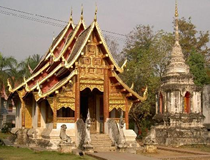CHIANG MAI CITY

Chiang Mai is the biggest and most-culturally significant city in the northern part of Thailand. It is located some 435 miles (700 km) north of Bangkok, between some of the tallest mountains in the country. It stands near the Ping river; an important tributary of the Chao Phraya.
In 1296, King Mengrai established the city of Chiang Mai or "the new city", succeeded the old Lanna kingdom capital, Chiang Rai. At the time, the city was encircled by a defensive wall and moat to repel Burmese raids. With the decline Lanna kingdom, Chiang Mai lost its importance and alternately occupied by Thais from Ayutthaya and the Burmese invaders. When the kingdom of Ayutthaya fell in April 1767, the city was heavily depopulated and the remaining inhabitants left the city in 1791.
However, the reinvigorated city finally became a part of Siam after the King Taksin assisted in its recapture from the Burmese invaders. Chiang Mai rose in economic, trading and cultural importance to its modern-day status as the most important city in the Northern Thailand, second only in significance to Bangkok.
CITY ATTTRACTIONS :
Wat Phra That Doi Suthep is a place visitors should see in Chiang Mai. The temple is located fifteen km from the city center and is a sacred ground for many Thai people. There are more than 300 steps; however it’s not particularly strenuous to climb. Lucky visitors will encounter hundred of monks arriving in a single file while climbing the steps. Those who want to skip the steps can ride a tram that costs 30 Baht or 50 Baht for a two-way ticket. Once inside the temple complex; people must be appropriately dressed and take off their shoes.
Wat Chiang Man is the oldest Buddhist temple in Chiang Mai. It was built in 1297 AD near the spot where by King Mangrai established a camp during the establishment of Chiang Mai as a new capital city. It houses two venerated and very important Buddha figures – Phra Satang Man (a crystal Buddha) and Phra Sila (a marble Buddha
Wat Phra Singh is another important temple in Chiang Mai. King Rama VIII (Ananda Mahidol), the older brother of the current King Rama IX (Bhumibol Adulyadej), bestowed it as the first grade Royal temple in 1935. Viharn Lai Kham is the most important part of the complex. In 1345, it was built to house a statue called Phra Buddha Singh, which is a classic example of Lanna style and culture. The murals of this complex are also highly noteworthy. They show the history of Suwanna Hongse and Songthong.
Wat Umong is a seven hundred years old Buddhist temple and lies against the Doi Suthep mountains. The wat is unique in that the Buddhist monks live in a natural surrounding, and occasionally feed the wild deer that live around the temple
It is suggested to visit Chiang Mai during the Tam Boon Khan Dok festival which last about a week. The celebration is focused around Wat Chedi Luang. Dancing, carnival games, musical performances, and the ubiquitous Thai food vendors are present. Many offerings are made to Lanna-era and Buddhist icons as well as the city pillar. This is a big celebration where most Chiang Mai residents participate.
Tourists can also visit the Elephant Nature Park, a rescue centre and sanctuary for elephants located about 60 km from Chiang Mai City. Established in the 1990s, the project's goal is to provide sanctuary for threatened and distressed elephants from many parts of Thailand. Located in a natural valley, surrounded by forested mountains and bordered by a river, the park and its surrounding area offers visitors a glimpse of quiet rural life.
